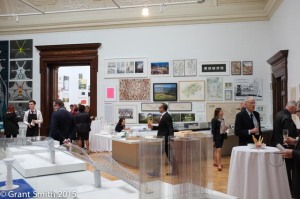On Monday the 1st of June I participated in an age old tradition that gives artists the chance to ‘retouch and varnish their pictures after they have been hung’ before the opening of the Summer Exhibition, attended by over 200,000 people during its opening time. Today there is little left to do, especially when your image is a framed inkjet hung on the wall beyond reach. The real purpose of the day is to meet fellow artists, section curators, admire your image on the wall of the venerable Royal Academy and witness the prize giving to the best in show, judged by the Academy. This is the first time I have had an image in the exhibition, and what an honour it is to be received into this instituion.
The day starts with a loose assembly of non-member artists, Royal Academy staff in hi-vis jackets and two policemen on bicycles in the courtyard of the RA. I waited in the courtyard, chatting with a fellow artist, and spied David Hockney in a grey suit, striding through the space, puffing on a cigarette.
Soon after 11.15am we walked through the gates on to Piccadilly, the traffic commanded to stop by either of the bicycled policemen. We were led out by the clerics from St. James’s church and a steel band, this procession of about 300 people walked eastwards along Piccadilly until we reached St. James’s. Filing through the north door of the church, negotiating the metal access ramp to the church, the band played us in with ‘When the Saints Go Marching In’.
After a sweet service for artists, and with a poetry reading by Ian Ritchie, architectural curator, who appended some of his own poetry to the reading, the vicar reflected on art and the Holy Trinity.
Departing the church, shaking hands with the vicar we crossed Piccadilly in a more ramshackle fashion than earlier, and then dispersed into the RA to sample wine and antipasti and enjoy the exhibition, spotting our various works through the gallery. A hum of excitement filled the air as fellow artists described where their work was hanging and considered how many previous shows they had exhibited in.
Prizes were declared by Christopher Le Brun, President of the RA, with the Grand Award for Architecture presented to Peter Barber, for his scheme at Mount Pleasant, titled Coldbath Town, by Bahadir Kayan of Turkish Ceramics
.
The event was a lovely celebration of an achievement I am immensely proud of, and so too all the other exhibitors. I was able to show my work to clients and friends who attended the event, and I now eagerly await the private view on Friday.




